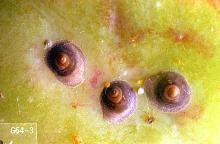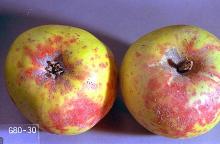Comstockaspis (Quadraspidiotus) perniciosus
Pest description and damage Scale insects are small (less than 0.125 inch in length) soft insects that live beneath waxy scales. These insects are often identified by the shape and size of their scales, the description of adult males and females, immature crawler stage, color of eggs, and host plant preferences. The San Jose scale was introduced to the U.S. on flowering peach in the 1870s. It is now a pest of all fruit trees and many ornamental and wild trees and shrubs throughout the U.S., particularly in hot, dry climates. The San Jose scale is differentiated from other scale insects by the scale (shell) that covers the adult females. The scale is about 0.06 inch in diameter, hard, gray to black, and cone-shaped, with a tiny white knob in the center. There is a series of grooves or rings around the white knob, and a purple halo on the bark around the scale.
Biology and life history The San Jose scale overwinters in an immature state under black shells. In spring, the tiny, winged males emerge and mate with wingless females still under their scales. Females give birth to live young about a month later (no eggs). Young scale insects, or "crawlers," are very small, flattened, and yellow, and move around on bark and foliage before settling down to feed. A few days later, they secrete a waxy coating over their body for protection. From this point, female scales will not move. Crawlers are present during June and July and again in August to September. There are two generations per year.
Pest monitoring Inspect twigs for these scales during the dormant season when bark is more visible. Pay attention to weak plants. Observe the young bark for purplish-red halos, which indicate infestation. In cherry orchards, scale-infested leaves of trees do not drop in fall, making scale detection straightforward. Bark of infested trees becomes rough in texture (healthy bark even on older trees is smooth). The crawlers are observed during June to July with a 10X magnifying glass. Crawlers are monitored by wrapping a piece of black sticky tape around an infested branch with the sticky side out. Pheromone traps will trap males to provide early warning and there is a degree-day model for predicting when crawlers will emerge.
Management-cultural control
Ensure ample water and cultural care with proper pruning cuts and management.
Management-biological control
Several parasitoids attack this scale. In fruit orchards, these parasitoids have not kept San Jose scale populations in check. In home orchards, where pesticides are used sparingly, the parasitoid has been more effective.
Management-chemical control
See Table 1 in:
Chemical Control of Landscape Pests
For more information
See "Scale insect" in:



